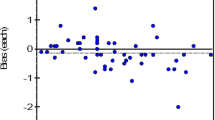Abstract
Dichlorophenol indophenol precipitation (DCIP) test is a screening method for unstable hemoglobins (Hb). An automatic system for a rapid DCIP test was developed based on stopped-flow hydrodynamic sequential injection. The system overcomes the problems of the conventional DCIP test such as long analysis time and imprecision, which are due to temperature fluctuation and imprecise detection timing. The flow based DCIP system can shorten the incubation time (usually 25 min to 1 h) to 3 min by using a higher temperature of 50°C instead of 37–40°C as in the conventional method. The reagents used were very simple and the whole process was done online with a microcontroller for controlling time. The clearness of the mixture was monitored with a spectrophotometer to improve precision as compared to the bare eyes observation method used in conventional DCIP test. The system could differentiate the HbE carriers (positive group) from negative group which agreed with the routine screening method using anion exchange micro-column.






Similar content being viewed by others
References
Bachir D, Galacteros F (2004) Hemoglobin E disease. In: Orphanet Encyclopedia. edited by Tchernia G. Available via DIALOG http://www.orpha.net/data/patho/GB/uk-HbE.pdf. Access 22 Dec 2008
Fuchareon G, Sanchaisuriya K, Sae-ung N, Dangwibul S, Fuchareon S (2004) A simplified screening strategy for thalassemia and haemoglobin E in rural communities in South-east Asia. Bull World Health Organ 82:364
Vichinsky E (2007) Hemoglobin E syndromes. Hematology 79:83
Weatherall DJ (1991) The Thalassemias. In: Hematology, 4th Int edn. McGraw-Hill, New York, p 627
Hempe JM, Craver RD (2000) Separation of hemoglobin variants with similar charge by capillary isoelectric focusing: Value of isoelectric point for identification of common and uncommon hemoglobin variants. Electrophoresis 21:743
Fuchareon S, Winichagoon P, Wisedpanichkij R, Sae-Ngow B, Sriphanich R, Oncoung W, Muangsapaya W, Chowthaworn J, Kanokpongsakdi S, Bunyaratvej A, Piankijagum A, Dewaele C (1998) Prenatal and postnatal diagnoses of thalassemias and hemoglobinopathies by HPLC. Clin Chem 44:740
Acemoglu H, Beyhun NE, Vancelik S, Polat H, Guraksin A (2008) Thalassemia screening in a non-prevalent region of a prevalent country (Turkey): is it necessary? Pub Health 6:620
Sanchaisuriya K, Fucharoen S, Fucharoen G, Ratanasiri T, Sanchaisuriya P, Changtrakul Y, Ukosanakarn U, Ussawaphark W, Schelp FP (2005) A reliable screening protocol for thalassemia and hemoglobinpathies in pregnancy. Am J Clin Pathol 123:113
Wiwanitkit V, Suwansaksri J, Paritpokee N (2002) Combined one-tube osmotic fragility (OF) test and dichlorophenol-indophenol (DCIP) test screening for hemoglobin disorders, an experience in 213 Thai pregnant woman. Clin Lab 48:525
Wiwanitkit V (2006) A cost utility analysis of the right method for screening hemoglobin E among Thai pregnant women. Arch Gynecol Obstet 274:88
Tongsong T, Sirichotiyakul S, Chaisen R, Wanapirak C (2006) Sensitivity and specificity of dichlorophenol-indophenol precipitation test to screen for the hemoglobin E trait in pregnant women. Int J Gynecol Obstet 95:149
Ithanet Electronic Infrastructure for Thalassemia Research Network. HbE detection by DCIP test PROTOCOL. In: Section Haematological procedures-General procedures. Available via DIALOG http://portal.ithanet.eu. Access 28 Aug 2009
Jaiwang P, Meemungthum I, Wiwanitkit V (2007) Positive DCIP rates: a study on laboratory incidence. Chula Med J 51:101
Ruzicka J, Hansen EH (1988) Flow injection analysis, 2nd edn. Wiley, New York, pp 15–25
Ruzicka J, Marshall GD (1990) Sequential injection: a new concept for chemical sensors, process analysis and laboratory assays. Anal Chim Acta 237:329
Somnam S, Grudpan K, Jakmunee J (2008) Hydrodynamic sequential injection spectrophotometric system for determination of manganese in soil. Spectro Lett 41:221
Somnam S, Jakmunee J, Grudpan K, Lenghor N, Motomizu S (2008) Determination of nitrite and nitrate in water samples by an automated hydrodynamic sequential injection method. Anal Sci 24:1599
Khonyoung S, Hartwell SK, Jakmunee J, Lapanatnoppakhun S, Sanguansermsri T, Grudpan K (2009) A Stopped flow system with hydrodynamic injection for red blood cells osmotic fragility test: a possibility for automatic screening of beta-thalassemia trait. Anal Sci 25:819
Atamna H (2006) Heme binding to amyloid-β peptide: mechanistic role in Alzheimer’s disease. J Alzheimer’s Disease 10:255
Atamna H, Boyle K (2006) Amyloid-b peptide binds with heme to form a peroxidase: Relationship to the cytopathologies of Alzheimer’s disease. PNAS 103:3381
Sirichotiyakul S, Tongprasert F, Tongsong T (2004) Screening for hemoglobin E trait in pregnant woman. Int J Obstet Gynecol 86:390
Tongsong T, Wanapirak C, Sirivatanapa P, Sanguansermsri T, Sirichotiyakul S, Piyamongkol W et al (2000) Prenatal control of severe thalassemia. Chiang Mai strategy Prenat Diagn 20:229
Acknowledgement
The authors thank the Commission on Higher Education (CHE) through Research Group (RG) grant for support. Additional supports from the Center for Innovation in Chemistry (PERCH-CIC) is also acknowledged.
Author information
Authors and Affiliations
Corresponding author
Rights and permissions
About this article
Cite this article
Hartwell, S.K., Kochasit, W., Kerdphon, S. et al. Hydrodynamic sequential injection system for a rapid dichlorophenol indophenol precipitation test for hemoglobin E. Microchim Acta 167, 201–209 (2009). https://doi.org/10.1007/s00604-009-0230-7
Received:
Accepted:
Published:
Issue Date:
DOI: https://doi.org/10.1007/s00604-009-0230-7




